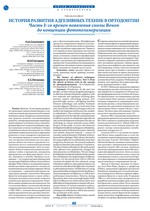История развития адгезивных техник в ортодонтии Часть I: со времен появления смолы bowen до концепции фотополимеризации


Научно-практический журнал Институт Стоматологии №1(98), апрель 2023
стр. 74-75
Аннотация
Введение. За последние двадцать лет произошел значительный прогресс в адгезии несъемной ортодонтической техники: появились новые материалы и вспомогательные средства, включая стеклоиономерные цементы, самопротравливающие праймеры, новые мощные источники света, самолигирующие брекеты (технология Дэймон) и другая концепция лечения (элайнеры). Однако потребовалось более шестидесяти лет, чтобы адгезивная техника получила свое современное развитие и стала стандартом в ортодонтии. Эту эволюцию прогресса можно объяснить тем, что арсенал адгезивных систем в ортодонтии зависит не только от развития стоматологии, но и от технологий в различных областях материаловедения. Цель исследования: обзор исторического развития адгезивных техник в ортодонтии, материалов, применяемых для фиксации брекет-системы. Материал и методы. Материал исследования — источники научной медицинской литературы (PubMed, eLibrary, ScienceDirect, Springer, Wiley Library), посвященной применению адгезивов в ортодонтии с момента их возникновения до настоящего времени. Метод исследования — аналитический (анализ литературных данных). Заключение. Фиксация брекетов непосредственно к эмали зубов с помощью адгезивов качественно изменила клиническую практику в ортодонтии. Разработка нового дизайна как металлических, так и эстетичных брекет-систем способствовала модернизации адгезивных систем. За период с 1962-1985 гг. учеными были разработаны первые ортодонтические адгезивы химического отверждения, позднее полимеризация осуществлялась ультрафиолетом с переходом к фотополимеризации. Модификация процессов отверждения привела к улучшению физико-химических свойств адгезивов, а также их рабочих характеристик. Однако в этот период не было проведено достаточно исследований влияния адгезивов на зубную эмаль, оставались сложности при фиксации брекетов к эмали с некариозными повреждениями, к различным реставрационным поверхностям. О дальнейших исследованиях и разработках адгезивных техник в ортодонтии будет изложено во второй части статьи.
Аннотация (англ)
Introduction. In the past two decades, we have witnessed significant progress in adhesion of fixed orthodontic appliance with new materials and auxiliaries involving glass ionomer cement, self-etching primers, new powerful light sources, self-ligating brackets (Damon technology) and another treatment concept (aligners). However, it took more than sixty years for the adhesive technique to have its modern development and become the standart in orthodontics. This evolution of progress can be explained to the fact that the armamentarium of adhesive systems in orthodontics depends not only on the development of dentistry but also on technology in various materials science fields. Purpose of this study: to review the historical development of adhesive techniques in orthodontics, materials used to fix the bracket system. Materials and methods. Research material — sources of scientific medical literature (PubMed, eLibrary, ScienceDirect, Springer, Wiley Library) devoted to the using of adhesives in orthodontics from their inception to the present. The research method is analytical (literature data analysis). Conclusion. The direct fixation of brackets to the teeth enamel with adhesives has qualitatively changed the clinical practice in orthodontics. The new design development of metal and aesthetic bracket systems has contributed to the modernization of adhesive systems. For the period from 1962 to 1985 the scientists developed the first chemical curing orthodontic adhesives, later polymerization was carried out with ultraviolet light with a transition to photopolymerization. Modification of curing processes has led to an improvement in the physico-chemical properties of adhesives, as well as their performance characteristics. However, during this period, there were not enough studies of the effect of adhesives on tooth enamel; there were difficulties in fixing brackets to enamel with non-carious lesions, to various restorative surfaces. Further research and development of adhesive techniques in orthodontics will be discussed in the second part of the article.
Ключевые Слова
адгезив, брекет-система, травление эмали, праймер, полимеризация.
Ключевые Слова (англ)
adhesive, bracket system, enamel etching, primer, polymerization.
Список литературы
/ REFERENCES:
1. Bowen R.L. Dental Filling material comprising vinyl silane treated silica and a binder consisting of the reaction product of Bis-phenol and Glycidyl acrylate. U.S.Patent Office, Pat №. 3:1962; 116-122.
2. Buonocore M.G. A simple method of increasing the adhesion of acrylic filling materials to enamel surface. J. Dent Res 1955; 34: 849-50.
3. Masuhara F., Miura A.N., Nakagawa S. New direct bonding system for plastic brackets. Am J Orthod 1971; 59: 350-355.
4. McNamara J.A.Jr. An orthopedic approach to the treatment of Class III malocclusion in young patients. J. Clin Orthod 1987; 21:598-608.
5. George V. Newman. A simple economical bonding adhesive. J. Clin Orthod 1980; 14: 273-77.
6. George V. Newman. Epoxy adhesives for orthodontic attachments, Progress report. Am J. Orthod 1965; 51: 901-912.
7. Tavas J., Watts M. Bonding of orthodontic brackets by transillumination of light activated composite an in vitro study. Br. J. of Orthod 1979; 6: 207-208.
1. Bowen R.L. Dental Filling material comprising vinyl silane treated silica and a binder consisting of the reaction product of Bis-phenol and Glycidyl acrylate. U.S.Patent Office, Pat №. 3:1962; 116-122.
2. Buonocore M.G. A simple method of increasing the adhesion of acrylic filling materials to enamel surface. J. Dent Res 1955; 34: 849-50.
3. Masuhara F., Miura A.N., Nakagawa S. New direct bonding system for plastic brackets. Am J Orthod 1971; 59: 350-355.
4. McNamara J.A.Jr. An orthopedic approach to the treatment of Class III malocclusion in young patients. J. Clin Orthod 1987; 21:598-608.
5. George V. Newman. A simple economical bonding adhesive. J. Clin Orthod 1980; 14: 273-77.
6. George V. Newman. Epoxy adhesives for orthodontic attachments, Progress report. Am J. Orthod 1965; 51: 901-912.
7. Tavas J., Watts M. Bonding of orthodontic brackets by transillumination of light activated composite an in vitro study. Br. J. of Orthod 1979; 6: 207-208.
Другие статьи из раздела «Обзор литературы в стоматологии»
- Комментарии
Загрузка комментариев...
|
Поделиться:
|

 PDF)
PDF)


